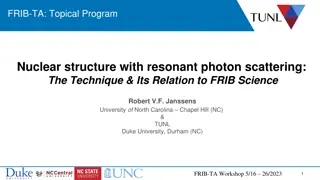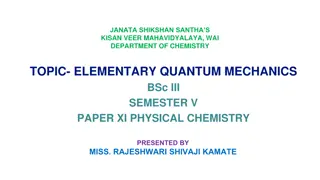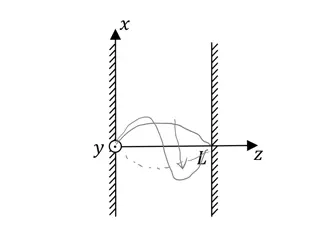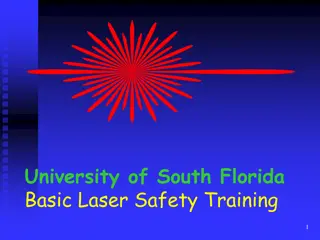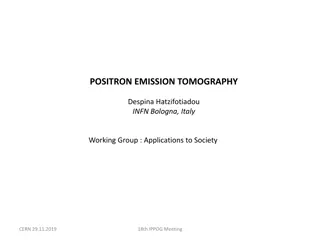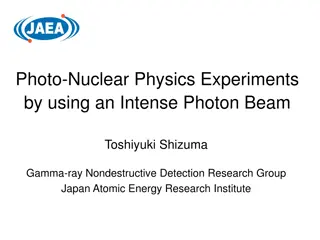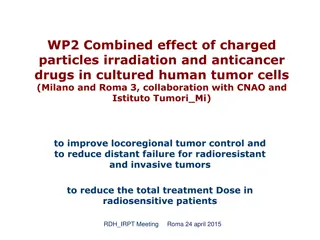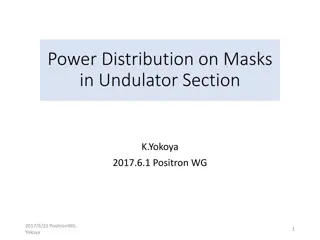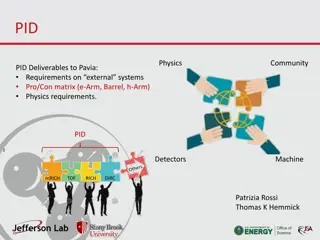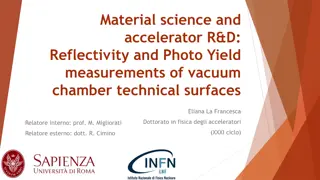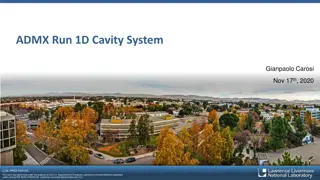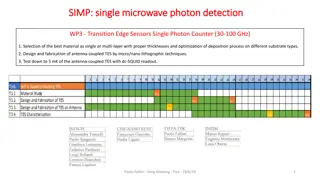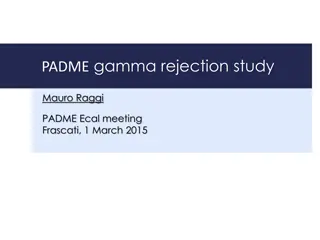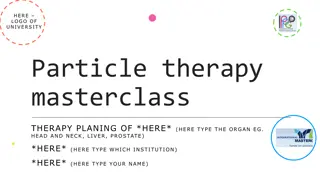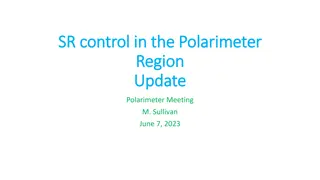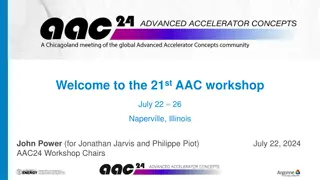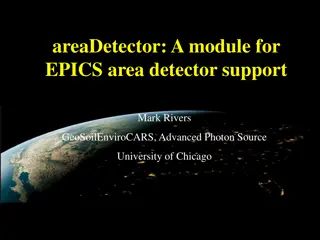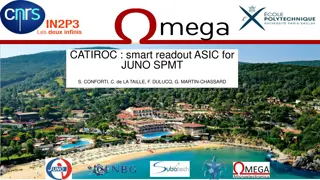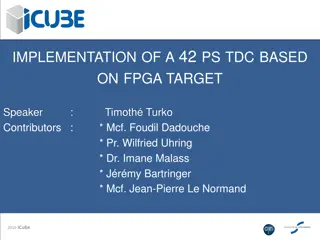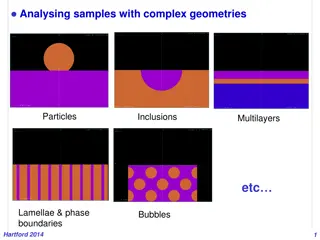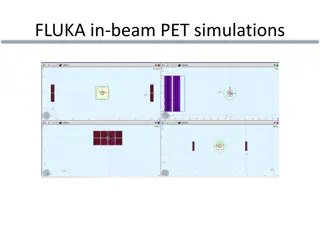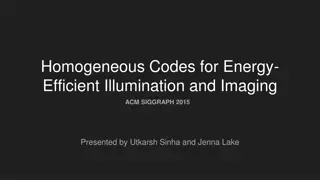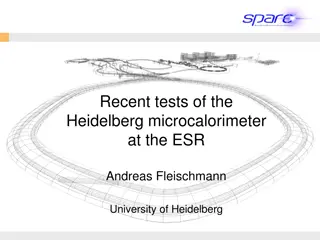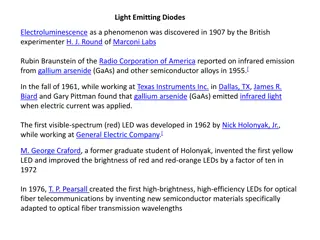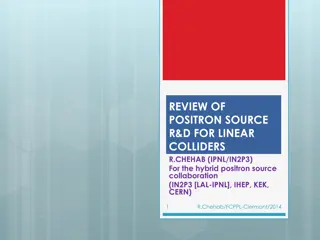Understanding Waves, Light, & Sound: Vocabulary and Concepts
This chapter covers essential vocabulary and concepts related to waves, light, and sound, including amplitude, crest, diffraction, Doppler effect, electromagnetic wave, frequency, interference, longitudinal wave, mechanical wave, medium, photon, pitch, reflection, refraction, sound wave, standing wa
8 views • 21 slides
Innovations in Pixel Detector Technology for Photon Science
Technologies and advancements in pixel detector development for photon science applications are showcased in this content. Topics discussed include balancing gain and dynamic range in hybrid pixel detectors, performance assessments of integrating pixel detectors, and strategies for photon detection
4 views • 21 slides
Physics Problem-Solving: Kinematics, Dynamics, and Laser Energy
Explore various physics problems involving linear kinematics, 2-dimensional motion, dynamics, laser energy, and more. Learn how to calculate velocities, distances, forces, energies, and photon properties in different scenarios.
5 views • 22 slides
Nuclear Structure Investigations with Resonant Photon Scattering at FRIB-TA Workshop
Explore nuclear structure using resonant photon scattering at the FRIB-TA Workshop. The High Intensity Gamma-ray Source facility enables research on photonuclear reactions, spin and parity determinations, and selective investigation of nuclear states. Learn about the technique's potential impact on
2 views • 33 slides
Heisenberg's Uncertainty Principle in Elementary Quantum Mechanics
Heisenberg's Uncertainty Principle, proposed by German scientist Werner Heisenberg in 1927, states the impossibility of simultaneously and accurately determining the position and momentum of microscopic particles like electrons. This principle challenges classical concepts of definite position and m
0 views • 49 slides
Search for Dark Photons Utilizing Advanced Germanium Detectors at University of South Dakota
Research at the University of South Dakota under the collaboration PIRE-GEMADARC focuses on developing advanced germanium detectors with low energy thresholds for detecting low mass dark photons. The study aims to optimize event detection using new Ge detectors with internal charge amplification. Th
0 views • 16 slides
Understanding Reach Characteristics in HEC-HMS Basin Modeling
Reach characteristics play a crucial role in hydrological modeling using HEC-HMS. Georeferenced reaches are essential for computing reach characteristics like slope, sinuosity, relief, and more. The process involves pre-processing drainage data before detailed reach characteristics can be obtained.
0 views • 5 slides
Understanding Quantum Aspects of Electromagnetic Oscillations
Exploring the quantum nature of electromagnetic oscillations through concepts such as wave-particle duality, quantum harmonic oscillators, photon-number states, coherent light, and squeezed light. Delve into non-classical states, vacuum states, potential wells, and more in the fascinating world of q
1 views • 15 slides
Understanding Laser Fundamentals and Components
Laser technology operates on the principles of monochromatic, coherent, and directional light emission, making it distinct from ordinary light sources. This training covers the fundamental aspects of laser operation, contrasting it with incandescent light, and delves into the common components found
0 views • 31 slides
Positron Emission Tomography: Applications in Society and Recent Developments
Positron Emission Tomography (PET) is a medical imaging technique focusing on metabolic differences in the body. By using positron-emitting radioisotopes, PET can detect how molecules are taken up by healthy and cancerous cells, aiding in accurate tumor localization with lower doses. The evolution o
0 views • 6 slides
Advanced Fission Experiments at University of Michigan
The University of Michigan, under the guidance of Dr. Sara A. Pozzi, conducts cutting-edge fission experiments leveraging organic scintillation detectors. These detectors offer advantages such as nanosecond-scale response times, energy proportionality, and scalability. The experiments focus on impro
0 views • 4 slides
Advanced Photon-Beam Experiments in Nuclear Physics Research
Explore cutting-edge experiments in nuclear physics using intense photon beams, nondestructive isotope detection, laser Compton scattering rays, and photon beams for fundamental collective motion studies. Learn about nuclear resonance fluorescence, dipole excitation strength distribution, and detail
0 views • 12 slides
Combined Effect of Charged Particles Irradiation and Anticancer Drugs in Cultured Human Tumor Cells
Research collaboration aimed to enhance locoregional tumor control and reduce distant failure by combining charged particles irradiation and anticancer drug Epothilone B in cultured human tumor cells from Milano and Roma. The study explores the impact on clonogenic survival, growth curves, and deter
0 views • 13 slides
Unveiling Dark Matter Mysteries Through Dark Photons
Delve into the exploration of dark matter through the lens of dark photons in the galactic center and detectors. Uncover the enigmatic nature of dark matter, its interactions, existing constraints, and our model with fermionic dark matter and a dark photon mediator. Discover strategies to evade cons
0 views • 18 slides
Understanding Chemical Reaction Kinetics: From Unimolecular to Three-Body Reactions
Explore the fundamental concepts of chemical reactions, including unimolecular reactions like thermolysis and photolysis, bimolecular reactions, and three-body reactions. Learn about rate constants, reaction mechanisms, and the impact of pressure on reaction rates. Discover how energy transfer, phot
0 views • 9 slides
Power Distribution Analysis in Undulator Section
The study focuses on analyzing the power distribution on masks in an undulator section to determine if the mask design is adequate. Key parameters such as power deposition at the masks, on the inner surface of the undulators, and the need for a collimator in front of the target are examined. Assumpt
0 views • 11 slides
PID Physics Community Deliverables to Pavia: Requirements and Developments
Requirements and developments of external systems and detectors (e-Arm, Barrel, h-Arm) for PID Physics Community to Pavia are detailed. The deliverables include Pro/Con matrices, physics requirements, and advancements in detectors such as mRICH, TOF, RICH, and DIRC. Various simulation results, advan
0 views • 13 slides
Overview of Electron/Positron Injector Linac Upgrades at KEK
The recent status of the Electron/Positron Injector Linac at KEK, presented by Kazuro Furukawa, highlights the mission to achieve 40 times higher luminosity in the SuperKEKB collider. The upgrades include low emittance, low energy spread injection beams with higher beam current, new high-current pho
0 views • 23 slides
Reflectivity and Photo-Yield Measurements for Vacuum Chamber Surfaces
Eliana La Francesca's doctoral research in accelerator physics focused on studying the impact of synchrotron radiation on vacuum chamber surfaces. By analyzing reflectivity and photo-yield measurements, the study explored detrimental effects such as photon-stimulated desorption, heat load on acceler
0 views • 32 slides
Key Upgrades for Cavity 1D in ADMX Experiment
The ADMX experiment at LLNL is undergoing key upgrades for Cavity 1D to enhance axion-to-photon conversion power. The upgrades aim to optimize frequency coverage, form-factor, and Q-factor, with a focus on improving physical and noise temperature. Replacing stainless steel with carbon fiber support
0 views • 11 slides
Research Project on Microwave Photon Detection with Transition Edge Sensors
Investigation and fabrication of TES materials for single photon detection in the microwave range, optimizing material selection, deposition processes, and antenna-coupled TES design. Tasks include materials characterization, antenna simulations, and TES microwave characterization. The project aims
0 views • 9 slides
Insights from PADME ECal Meeting: Rejection Studies and BG Analysis
Explore the discussions and findings from the PADME ECal meeting on topics such as gamma rejection studies, toy MC studies of gamma background, ECAL geometrical definitions, BG studies, and detector acceptance. Key points include the proposal for a lead glass-based SAC and considerations on ineffici
0 views • 27 slides
Comparison of Photon, Proton, and Carbon Ion Therapy for Liver Cancer
This document elaborates on the comparison of photon, proton, and carbon ion therapy for liver cancer. It includes abstract, phantom CT scan analysis, organ delineation, photon vs. proton therapy comparisons, and proton vs. carbon ion therapy comparisons with corresponding images. Detailed discussio
0 views • 11 slides
Symposium on Positron Emission Tomography and Boron Neutron Capture Therapy Time-Over-Threshold Calibration in J-PET
The 3rd Symposium on Positron Emission Tomography and 1st Symposium on Boron Neutron Capture Therapy focused on Time-Over-Threshold calibration within the framework of J-PET. The event outlined experimental details, event selection, results, and key features of the Jagiellonian Positron Emission Tom
0 views • 35 slides
Advancements in Single Electron Phase-Space Tracking
Advancements in single electron studies are crucial for beam control and diagnostics in storage rings. Tracking betatron oscillations of a single electron opens up new possibilities for understanding particle dynamics and machine performance. The experimental setup involves using a digital camera an
0 views • 17 slides
Update on Polarimeter Meeting with M. Sullivan
Presenting a recap of issues regarding the 18 GeV and 10 GeV polarimeter regions, including details on photon windows, power densities, mask suggestions for absorbing radiation, and engineering considerations. The content also discusses the SR power from bend magnets and water cooling requirements f
0 views • 26 slides
Searching for Dark Photon Dark Matter with Cosmic Ray Antideuterons
Exploring the use of cosmic ray antideuterons for dark matter detection is a promising avenue in astrophysics. Antideuteron searches offer a low-background environment, making them ideal for detecting certain types of dark matter particles. Unlike antiproton searches, which face significant backgrou
0 views • 30 slides
Longitudinal Top-Up Injection for Small Aperture Storage Rings
In 3rd generation light sources, achieving lower emittances requires smaller physical apertures. Top-up injection is essential for stable photon beam flux, but introduces beam disturbances in transversely on-axis injection chicanes. Various injection schemes like conventional, multipole kicker, swap
0 views • 19 slides
Advanced Accelerator Concepts Workshop Highlights and Vision
The 21st AAC workshop held in Naperville, Illinois, showcased research on advanced accelerator physics and engineering. Key themes included developing cost-effective facilities for high-energy physics and photon science, as well as compact facilities for industrial, medical, and security application
0 views • 10 slides
Understanding EPICS areaDetector Module for Advanced Photon Source at University of Chicago
This content delves into the areaDetector module for EPICS, supporting various detectors used in research settings like synchrotron beamlines. It covers the motivation, goals, architecture, data structures, and detector drivers involved, emphasizing the versatility, efficiency, and support provided
0 views • 35 slides
Exploring Quantum Information through Polarization of Photons
Quantum information and photon polarization are explored in this detailed presentation featuring the ultimate quantum 2-state system. The content delves into the behavior of single photons at a quantum level, showcasing the intriguing properties and implications of quantum superposition in polarizat
1 views • 14 slides
Advancements in CATIROC Technology for Neutrino Observatories
CATIROC is a smart readout ASIC developed for experiments like JUNO, a neutrino observatory. With applications in photon counting, energy measurement, and data processing, CATIROC offers advanced features such as charge and time measurements, digital data conversion, and trigger outputs for improved
0 views • 20 slides
Implementation of a 42-PS TDC Based on FPGA Target
Context: Time-to-Digital Converter (TDC) architecture, methodology, and realization for high-throughput time-correlated single-photon counting in microfluidic droplets. Fluorescence Lifetime (FL) measurements offer high system sensitivity and accuracy. TDC specification for FPGA target with temporal
0 views • 21 slides
Advanced Simulation Techniques for Analyzing Samples with Complex Geometries
Explore the capabilities of PENELOPE simulation software for analyzing samples with intricate structures like particles, inclusions, multilayers, lamellae, and phase boundaries. The software facilitates detailed investigations of material composition and electron-photon transport in diverse geometri
0 views • 28 slides
Advanced Imaging Simulations for Hadrontherapy and PET Procedures
Explore advanced FLUKA in-beam PET simulations and Hadrontherapy activity-based generator for precise treatment planning. Speed up simulations using cloud computing and bias activity-based generators for faster workstation processing. Understand components needed for hadrons treatment simulation, in
2 views • 11 slides
Energy-Efficient Illumination and Imaging Techniques for Structured Light Applications
This presentation at ACM SIGGRAPH 2015 by Utkarsh Sinha and Jenna Lake explores the use of homogeneous codes to optimize energy efficiency in structured light applications. The focus is on distinguishing between translucency and inter-reflections, removing artifacts, reconstructing 3D objects in cha
0 views • 34 slides
Recent Tests of Heidelberg Microcalorimeter and New National Detector Laboratory Initiatives
Recent tests of the Heidelberg microcalorimeter at the ESR Andreas Fleischmann University of Heidelberg showcase advancements in X-ray photon research with metallic magnetic calorimeters. Additionally, a new initiative is discussed towards establishing a National Detector Laboratory by Thomas Stöhl
0 views • 15 slides
Modern Physics Concepts in the 20th Century: Photons, Uncertainty, and Particle-Wave Duality
Modern physics in the 20th century blurred the lines between particles and waves, introducing concepts like photons, Heisenberg's uncertainty principle, and the dual nature of matter. Topics covered include the behaviors of electromagnetic waves, the photon concept, and the limitations of measuring
0 views • 23 slides
Evolution of Light Emitting Diodes: From Discovery to Modern Applications
The history of Light Emitting Diodes (LEDs) dates back to the early 20th century, with significant milestones such as the discovery of electroluminescence in 1907 and the development of visible-spectrum LEDs in the 1960s. LEDs operate based on a semiconductor chip doped with impurities to create a p
0 views • 11 slides
Review of Positron Source R&D for Linear Colliders by R. Chehab
Intense positron sources, whether polarized or not, are vital for future e+e- linear colliders. This review covers different types of e+ sources, including circularly polarized photons and methods to obtain polarized positrons. Techniques such as helical magnetic undulators and Compton backscatterin
0 views • 26 slides


